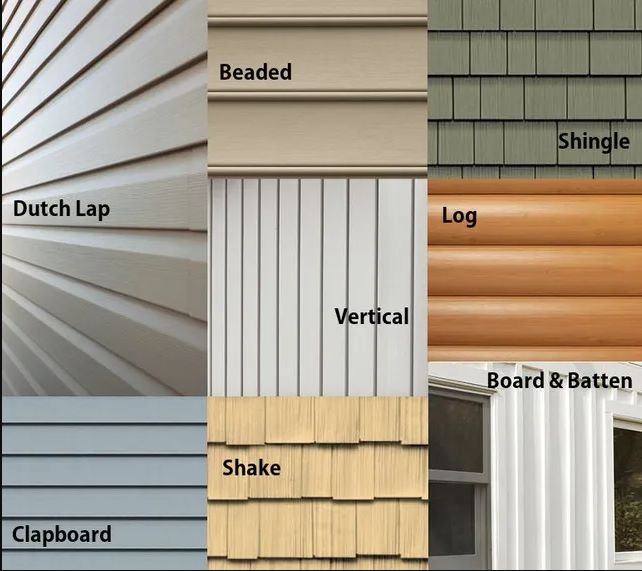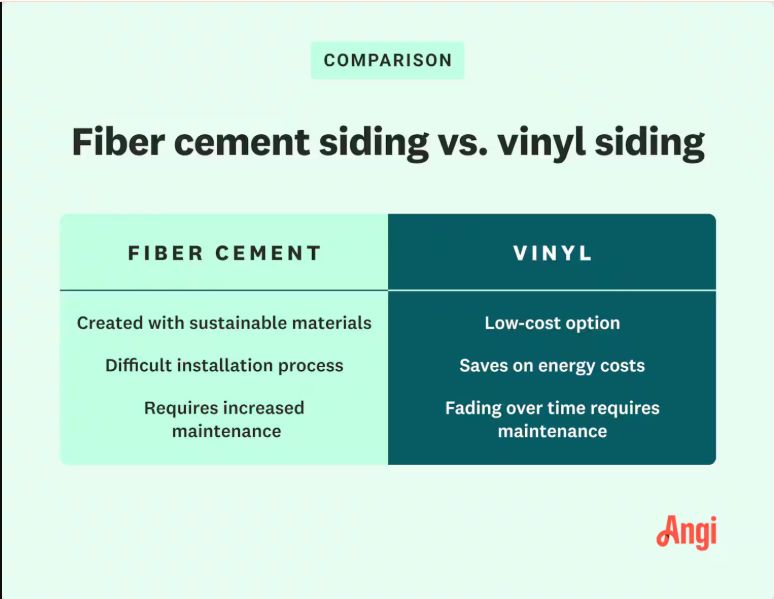Last updated on December 16th, 2024 at 03:48 pm
Vinyl siding is a popular exterior material made from polyvinyl chloride (PVC) and designed to enhance the appearance of homes. Its affordability, durability, and versatile design have helped it gain widespread acceptance among homeowners looking for an efficient, aesthetically pleasing solution for their property. For expert siding installation, repair, and replacement services in Garrettsville and nearby areas in Ohio, visit our Siding Services Page to learn more about how we can enhance your home’s exterior.
Table of Contents
What Is Vinyl Siding?
Vinyl siding is an exterior cladding material made from polyvinyl chloride (PVC). It protects homes while enhancing curb appeal, offering durability, affordability, and low maintenance.
Benefits of Vinyl Siding
Vinyl siding is one of the most popular exterior cladding choices for homeowners due to its affordability, durability, and visual appeal. Here are the key benefits:
1. Durability:
- It resists extreme weather, water, and insects.
- Long-lasting performance that becomes less important over time.
2. Low Maintenance:
- Cleaning with a garden hose and mild soap is only needed occasionally.
- No painting or staining is required, saving time and money.
3. Cost-Effectiveness:
- Affordable, upfront cost and minimal maintenance expenses.
- A financially savvy investment for long-term savings.
4. Energy Efficiency:
- Insulated vinyl siding reduces heating and cooling costs by increasing thermal efficiency.
5. Curb Appeal:
- It has various colors and textures to match individual styles and local aesthetics.
6. Weather Resistance:
- It protects homes from rain, wind, and temperature fluctuations, providing longevity.
Types of Vinyl Siding

Source: lirp.cdn
Choosing the right vinyl siding depends on your home’s style and needs. Here are the popular types:
1. Horizontal Lap Siding
- The classic look for traditional homes.
2. Vertical Siding
- The modern aesthetic is often applied to accent walls.
3. Shake and Shingle Siding:
- It mimics cedar shingles in style.
4. Board and Batten Siding:
- Vertical panels for farmhouse style appeal.
5. Insulated Vinyl Siding:
- It also improves energy efficiency and noise reduction.
How to Choose the Best Vinyl Siding for Your Home
Consider these factors when selecting vinyl siding:
- Color Selection: Choose a shade that complements the architecture and look of your home.
- Thickness and Quality: Thicker panels offer better durability and insulation.
- Finishes and Textures: Choose a smooth, wood grain or stone-like finish to suit your style.
- Warranty and Lifespan: Look for reputable vinyl siding manufacturers offering a quality warranty.
Vinyl Siding vs. Other Materials
Vinyl Siding vs. Wood
- Wood: Provides natural beauty but needs constant maintenance.
- Vinyl: Low maintenance and low cost.
Vinyl Siding vs. Fiber Cement
- Fiber Cement: Durable and fire-resistant but heavier and more expensive.
- Vinyl: Lightweight, easy to install, and inexpensive.
Vinyl Siding vs. Aluminum
- Aluminum: Durable and fireproof but prone to dents.
- Vinyl: Resistant to dents and available in more design options.
What Are The Pros And Cons Of Vinyl Siding?
Vinyl siding is popular with homeowners, balancing affordability, durability, and versatility. Here is an in-depth analysis of its pros and cons.
Pros:
- Durable Exterior Siding: Durable and resistant to environmental stress.
- Affordable Siding Materials: Cost-effective compared to wood or fiber cement.
- Low-Maintenance Siding: Requires minimal maintenance.
- Weather-Resistant Vinyl Siding: Performs well in a variety of climates.
- Siding for Energy Efficiency: Insulated options reduce energy costs.
Cons:
- Potential for Cracking and Warping: Vulnerable to extreme temperatures and impacts.
- Environmental Concerns: Non-biodegradable material.
- Color Fading: Prolonged exposure to UV can cause discoloration.
- Difficulty in Repairs: Replacing matching colors and fonts can be difficult.
Vinyl siding is a practical and affordable option for many homeowners, offering advantages such as low maintenance, energy take time and effort versatility, but potential drawbacks must be carefully balanced results such as damage sensitivity, environmental impact, and minimal impact on home resale value. It will help to ensure that vinyl siding is right for your house.
Popular Vinyl Siding Colors for 2025

The vinyl siding color trends of 2025 showcase a mix of classic neutrals and bold, modern shades. Here’s a breakdown of the top choices and their unique appeal:
Trending Shades:
- White: Timeless and versatile.
- Navy Blue: Elegant and modern.
- Grey: He is a neutral favourite.
- Black: Bold and modern.
- Green: Earthy and natural.
- Light Blue: Classic and simple.
- Brown: Warm and inviting.
- Beige: Subtle and complex.
- Red: Warm and optional.
- Red: Cheerful and bright.
Trends and Practical Considerations
These color choices reflect a balance of aesthetic appeal and functionality. In 2025, homeowners have resorted to shading that:
- Enhance Energy Efficiency: Lighter colors like white and beige convey warmth, while darker colors like navy and black can create warmth in colder areas.
- Minimize Maintenance: Neutrals like gray and beige hide dirt and hold it better over time.
- Align with Design Trends: Solid colors like red and black are gaining popularity for their modern appeal.
Choosing the right color scheme increases a home’s curb appeal and ensures it stands out while blending perfectly with its surroundings.
What colors are available for vinyl siding?
Vinyl siding is available in a variety of colors, including:
- Classic neutrals like white, beige, and gray
- Bold options like red, navy blue, and black
- Earthy tones like green and brown
- Bright, cheerful shades like yellow
Durable and Stylish Vinyl Siding Options for Homes
Enhance your home’s exterior with modern siding styles that combine durability and visual appeal. Whether you prefer the rustic charm of shake siding or the energy efficiency of insulated panels, vinyl siding manufacturers offer solutions to meet diverse needs.
Durability Comparison: Vinyl Siding vs. Fiber Cement Siding

Source: media.angi
When comparing durable vinyl siding to fiber cement siding, several key factors highlight the strengths and weaknesses of each material:
Fiber Cement Siding:
- Exceptional Resistance: Fiber cement siding is known for its strong resistance to fire, moisture, and insects. It is easy to crack or warp, making it a reliable choice for various climates.
- Longevity: Fiber cement can typically last between 30 and 50 years, depending on the quality of maintenance and installation. Many products exhibit this longevity and come with a warranty.
- Impact Resistance: Its rugged structure is better able to withstand the impact of hail and falling objects than its vinyl siding.
Vinyl Siding:
- Weather Resistance: Vinyl siding is designed to resist cracking and peeling in various weather conditions. Its flexibility allows it to handle temperature fluctuations better, helping to prevent cracking during snow and ice cycles.
- Lifespan: Vinyl siding generally lasts about 20 to 30. However, exposure to harsh weather or prolonged UV exposure can accelerate deterioration, leading to fading and discoloration.
- Risk for Damage: Although vinyl is highly resistant, it can be more susceptible to corrosion from extreme weather conditions than fiber cement. Strong winds or hail can cause vinyl sideways to be loose or cracked.
In summary, although both materials provide durability compared to traditional wood decking, fiber cement generally outperforms vinyl in terms of time-long flexibility and longevity. The excellent resistance of fiber cement to environmental stresses makes it ideal for harsh climatic environments. In contrast, vinyl siding is inexpensive and requires little maintenance but can provide long-term durability. When choosing between the two options, homeowners should weigh these factors based on their needs and local climate.
Maintenance of Vinyl Siding
Routine maintenance includes:
- Cleaning: Remove dirt with simple tools such as a hose or pressure washer.
- Inspection: Check regularly for cracks or discoloration.
- Repairs: Treat the damaged part immediately to maintain integrity.
How Can I Maintain My Vinyl Siding?
To maintain vinyl siding, follow these steps:
- Clean regularly: Use a garden hose or pressure washer to remove dirt.
- Inspect for damage: Check for cracks, warping, or discoloration.
- Repair promptly: Replace damaged sections to maintain appearance and protection.
What are decorative siding options?
Decorative vinyl siding options include:
- Shake and Shingle Siding: Mimics the look of cedar shingles for a rustic feel.
- Board and Batten Siding: Offers vertical planks for farmhouse-style charm.
- Custom Textures: Wood-grain or stone-like finishes for enhanced aesthetics.
How can I get rid of bees in the siding?
To remove bees nesting in vinyl siding, consider these steps:
- Use a bee repellent or insecticide spray.
- Seal entry points with caulk or foam.
- Consult a professional exterminator for safe and effective removal.
Pally Roofing: Expert Vinyl Siding Services
With over 15 years of experience in Garrettsville and nearby Ohio areas, Pally Roofing specializes in:
- Vinyl Siding Installation: Customized to fit any property.
- Durable Materials: High-quality siding that withstands harsh conditions.
- Comprehensive Services: From consultation to maintenance.
- Customer Satisfaction: Guaranteed by expert service and reliable products.
Additional Services
- Window Replacement: Boost energy efficiency.
- Roofing Solutions: Complement your home’s exterior.
- Exterior Home Makeovers: Integrated roofing, siding, and window services.
Conclusion
Vinyl siding offers homeowners an affordable, durable, and visually appealing way to protect and enhance the appearance of their homes. Whether you’re looking for energy efficiency, low maintenance, or a stylish design, vinyl siding delivers on all fronts—working with Pally Roofing in Garrettsville and nearby areas in Ohio for professional installation and quality to get you the exterior it wants for your home. If you’re considering replacing your vinyl siding, read our guide on How to Replace Vinyl Siding for helpful tips and expert advice.
Frequently Asked Questions
How Long Does Vinyl Siding Last?
Proper maintenance means vinyl siding can last between 20 and 40 years, depending on quality and environmental conditions.
Can Vinyl Siding Be Painted Or Stained?
Yes, vinyl siding can be painted, but it’s essential to use paint specifically designed for vinyl to ensure proper adhesion and durability.
How Much Does Vinyl Siding Cost Per Box?
The cost per box of vinyl siding varies depending on the brand, style, and thickness. On average, it ranges from $90 to $250 per box, with higher-quality materials or insulated options on the higher end.
What Are The Benefits Of Insulated Vinyl Siding?
Insulated vinyl siding improves energy efficiency by reducing heat transfer through walls. It also reduces noise, enhances home comfort, and contributes to lower heating and cooling costs.
What Is The R-Value Of Insulated Siding?
The R-value of insulated siding varies but typically ranges from 2.0 to 3.5, depending on the material. This added insulation enhances thermal performance, making homes more energy-efficient.
Can Vinyl Siding Warp From The Sun?
Yes, vinyl siding can warp or become discolored from prolonged exposure to intense sunlight or high heat, such as from BBQs or reflected light. Choosing high-quality, UV-resistant siding can reduce this risk.
Is Vinyl Siding Eco-Friendly?
Vinyl siding has environmental concerns due to its production and non-biodegradable nature. However, it requires fewer resources to maintain over its lifespan compared to materials like wood.
Can I Paint My Vinyl Siding?
Yes, vinyl siding can be painted using acrylic-based exterior paint.
What Is Straight-Lap Vinyl Siding?
Straight lap siding is a classic horizontal siding style in traditional home designs. It offers a clean, uniform look and is one of the most popular vinyl siding options.
When Did Vinyl Siding First Become Available?
Vinyl siding was introduced in the late 1950s as a durable, low-maintenance alternative to traditional wood siding. Its popularity grew in the 1970s due to manufacturing and color options advancements.
Author
-

With more than 16 years of hands-on experience, Phillip Schmucker is the knowledgeable owner of Pally Roofing. His dedication to superior roofing services has earned him a reputable place in the industry. Phillip also shares his extensive expertise through writing, providing readers with practical tips and professional advice on various roofing topics. Follow him on LinkedIn.
View all posts






